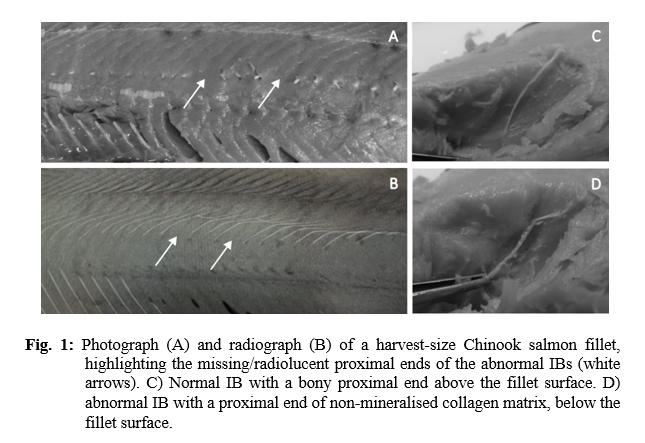GUARANTEED BONE FREE? NOVEL INTERMUSCULAR BONE ABNORMALITIES IN CHINOOK SALMON Oncorhynchus tshawytscha AND THEIR IMPLICATIONS FOR AQUACULTURE
Introduction
Skeletal deformities are a persistent welfare and production issue for salmonid aquaculture, including New Zealand farmed Chinook salmon (Oncorhynchus tshawytscha). Research on deformities of the fine bones, such as intermuscular bones (IBs) and ribs, have received much less attention than vertebral deformities in salmon musculoskeletal research1-3. IBs, commonly known as pin bones, are small spicule-like bones, present in the muscle fillets of basal teleost species. IBs are removed during fish processing, as they present a human health risk if ingested. IB abnormalities can cause technical difficulties in the automated or manual removal of IBs at processing. Furthermore, the proposed role of IBs in swimming efficiency, emphasises the potential welfare implications of IB abnormalities. However, there are significant knowledge gaps about the function and development of IBs1. IB abnormalities were first identified on a significant scale in a population of harvest-size Chinook salmon, during fish processing. The IBs presented as incompletely mineralised at the proximal end, which caused difficulties in removal1 (Fig. 1). To our knowledge, this is the first account of IB abnormalities in farmed salmonids in the literature. Thus, we aimed to characterise this novel bone abnormality and identify any association with vertebral deformities.
Materials and methods
A subsample of the affected population (n = 118), (weight = 5081.86 ± 134.69 g, fork length = 679.07 ± 5.5 mm, mean ± SEM) previously stored at -20°C, were weighed, measured, and whole-body and fillets x-rayed. The prevalence and severity of IB abnormalities and vertebral deformities were scored from x-rays. Fish were categorised into two groups: <25% abnormal and >25% abnormal IBs. Normal and abnormal bones (n = 71 normal and 61 abnormal bones from 16 fish, n = 8 fish per group) were selected for: mechanical (breaking load) analyses using a TA.XT texture analyser; calcium and phosphorus content via ICP-MS (n = 12 fish); and osteocyte density by histological examination (n = 6 fish). The significance level was set at p ≤ 0.05 for Wilcoxon signed-rank tests. For analyses conducted within the Bayesian framework, effects were considered meaningful if the 95% credible interval (CI) of the posterior distribution excluded zero.
Results and discussion
The individuals assessed had 62 ± 0.18 IBs (31 per fillet). IB abnormalities were present in all fish sampled, with prevalence varying among individuals. Fish with higher prevalence, (>50% of abnormal IBs), were smaller (4773 ± 126 g) than those with lower prevalence (<10%) (5464 ± 178 g). The position of abnormal IBs along the vertebral column was asymmetric. The left fillet had a significantly higher (p <0.001) number of abnormal IBs than the right fillet (9.85 ± 0.58 vs 7.82 ± 0.51). Vertebral deformities were also present in over half of the fish, i.e. compression, fusions or vertical shifts (25%), spinal curvature (14%) or both (15%). There was no association between IB abnormalities and vertebral deformities occurrence (β = -0.06, 95% CI = -0.31, 0.18).
Abnormal IBs had significantly lower (β = -3.43, 95% CI = -5.56, -1.32) breaking load, but only a numerically lower phosphorus content (p = 0.72). IBs of fish with >25% abnormal IBs had significantly lower (β = -2.34, 95% CI = -4.12, -0.51) breaking load for both normal and abnormal bones, relative to the <25% group. No difference in mineral content between normal and abnormal bones suggested the need to compare unaffected fish.
Abnormal IBs had significantly fewer osteocytes than normal bones (preliminary analysis). The reduced number of osteocytes in abnormal IBs may be indicative of variation in bone growth rate and mineralisation. Our findings suggest that the physical and mechanical changes in abnormal IBs are indicative of altered IB development, and possible bone remodelling issues. Moreover, IB abnormalities are independent of vertebral deformities in Chinook salmon. The occurrence of IB abnormalities is a unique example of how musculoskeletal disorders can go by undetected, with unknown consequences on welfare and performance, and until fish are on the plate and it’s too late.
References
1. Lyall BA, Witten PE, Carter CG, et al. The problems with pin bones: Intermuscular bone development and function in salmonids and their implications for aquaculture. Reviews in Aquaculture. 2024;16(4):1981-1995. doi:10.1111/raq.12942
2. Jiménez-Guerrero R, Baeverfjord G, Evensen Ø, Mørkøre T. Understanding morphological rib abnormalities in Atlantic salmon. Aquaculture. 2024;doi:10.1016/j.aquaculture.2024.741140
3. Brimsholm M, Fjelldal PG, Hansen T, et al. Anatomical and pathological characteristics of ribs in the Atlantic salmon (Salmo salar L.) and its relevance to soft tissue changes. Anatomia Histologia Embryologia. 2023;52:421-436. doi:10.1111/ahe.12900
